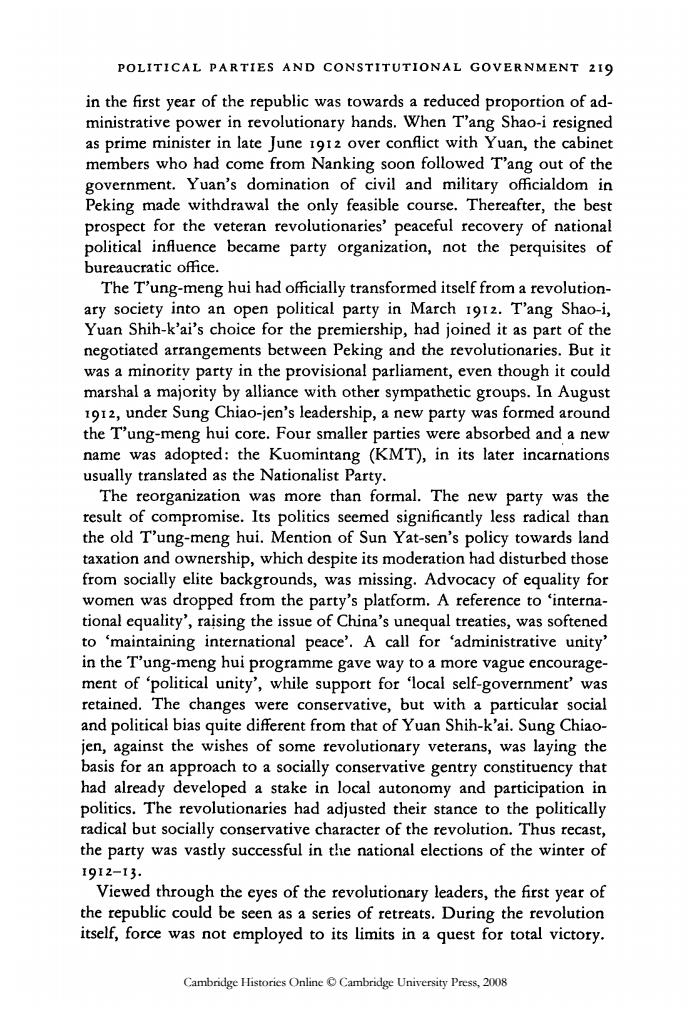正在加载图片...

POLITICAL PARTIES AND CONSTITUTIONAL GOVERNMENT 2I9 in the first year of the republic was towards a reduced proportion of ad- ministrative power in revolutionary hands.When T'ang Shao-i resigned as prime minister in late June Iorz over conflict with Yuan,the cabinet members who had come from Nanking soon followed T'ang out of the government.Yuan's domination of civil and military officialdom in Peking made withdrawal the only feasible course.Thereafter,the best prospect for the veteran revolutionaries'peaceful recovery of national political influence became party organization,not the perquisites of bureaucratic office. The T'ung-meng hui had officially transformed itself from a revolution- ary society into an open political party in March I91z.T'ang Shao-i, Yuan Shih-k'ai's choice for the premiership,had joined it as part of the negotiated arrangements between Peking and the revolutionaries.But it was a minority party in the provisional parliament,even though it could marshal a majority by alliance with other sympathetic groups.In August 1912,under Sung Chiao-jen's leadership,a new party was formed around the T'ung-meng hui core.Four smaller parties were absorbed and a new name was adopted:the Kuomintang (KMT),in its later incarnations usually translated as the Nationalist Party. The reorganization was more than formal.The new party was the result of compromise.Its politics seemed significantly less radical than the old T'ung-meng hui.Mention of Sun Yat-sen's policy towards land taxation and ownership,which despite its moderation had disturbed those from socially elite backgrounds,was missing.Advocacy of equality for women was dropped from the party's platform.A reference to 'interna- tional equality',raising the issue of China's unequal treaties,was softened to 'maintaining international peace'.A call for 'administrative unity' in the T'ung-meng hui programme gave way to a more vague encourage- ment of political unity',while support for local self-government'was retained.The changes were conservative,but with a particular social and political bias quite different from that of Yuan Shih-k'ai.Sung Chiao- jen,against the wishes of some revolutionary veterans,was laying the basis for an approach to a socially conservative gentry constituency that had already developed a stake in local autonomy and participation in politics.The revolutionaries had adjusted their stance to the politically radical but socially conservative character of the revolution.Thus recast, the party was vastly successful in the national elections of the winter of I9I2-I3. Viewed through the eyes of the revolutionary leaders,the first year of the republic could be seen as a series of retreats.During the revolution itself,force was not employed to its limits in a quest for total victory. Cambridge Histories Online Cambridge University Press,2008POLITICAL PARTIES AND CONSTITUTIONAL GOVERNMENT 219 in the first year of the republic was towards a reduced proportion of administrative power in revolutionary hands. When T'ang Shao-i resigned as prime minister in late June 1912 over conflict with Yuan, the cabinet members who had come from Nanking soon followed T'ang out of the government. Yuan's domination of civil and military officialdom in Peking made withdrawal the only feasible course. Thereafter, the best prospect for the veteran revolutionaries' peaceful recovery of national political influence became party organization, not the perquisites of bureaucratic office. The T'ung-meng hui had officially transformed itself from a revolutionary society into an open political party in March 1912. T'ang Shao-i, Yuan Shih-k'ai's choice for the premiership, had joined it as part of the negotiated arrangements between Peking and the revolutionaries. But it was a minority party in the provisional parliament, even though it could marshal a majority by alliance with other sympathetic groups. In August 1912, under Sung Chiao-jen's leadership, a new party was formed around the T'ung-meng hui core. Four smaller parties were absorbed and a new name was adopted: the Kuomintang (KMT), in its later incarnations usually translated as the Nationalist Party. The reorganization was more than formal. The new party was the result of compromise. Its politics seemed significantly less radical than the old T'ung-meng hui. Mention of Sun Yat-sen's policy towards land taxation and ownership, which despite its moderation had disturbed those from socially elite backgrounds, was missing. Advocacy of equality for women was dropped from the party's platform. A reference to 'international equality', raising the issue of China's unequal treaties, was softened to 'maintaining international peace'. A call for 'administrative unity' in the T'ung-meng hui programme gave way to a more vague encouragement of 'political unity', while support for 'local self-government' was retained. The changes were conservative, but with a particular social and political bias quite different from that of Yuan Shih-k'ai. Sung Chiaojen, against the wishes of some revolutionary veterans, was laying the basis for an approach to a socially conservative gentry constituency that had already developed a stake in local autonomy and participation in politics. The revolutionaries had adjusted their stance to the politically radical but socially conservative character of the revolution. Thus recast, the party was vastly successful in the national elections of the winter of 1912-13. Viewed through the eyes of the revolutionary leaders, the first year of the republic could be seen as a series of retreats. During the revolution itself, force was not employed to its limits in a quest for total victory. Cambridge Histories Online © Cambridge University Press, 2008